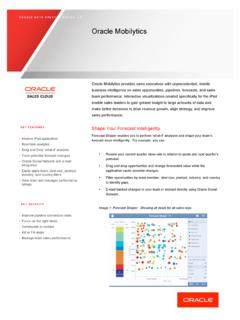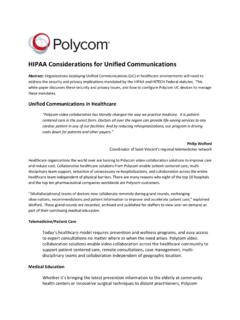Transcription of Gartner: The Future of Videoconferencing - Bitpipe
1 gartner : The Future of Videoconferencing Robert Mason, research director at gartner With a transition to new endpoints, capabilities and services, changes are on the horizon for Videoconferencing , and the emphasis is now shifting to improving endpoint coverage and adding reach. Videoconferencing solutions that demonstrate business value have a consistent balance of quality, repeatability and ease-of-use. Although each of these attributes is difficult to perfect, improving video quality has been the primary focus of Videoconferencing vendors. Standard-definition systems with direct-view displays offered compelling eye contact only for callers willing to pan-tilt-zoom, while content shared on standard definition was virtually unreadable.
2 New internet protocol (IP) video codecs (such as ) promised "the same quality for half the bandwidth"; however, they were implemented by customers for "better video quality at the same bandwidth," indicating a latent desire for improved video quality. Although telepresence did not mark the end of improvements in video resolution, it marked the point at which video quality became sufficient for most use cases. Emphasis has now shifted to multiple (and larger) displays of like quality, with product development and marketing messages moving to bandwidth efficiency. polycom 's implementation of the Hi-Profile codec is a recent example of this trend, underscoring an "HD for half the bandwidth" value proposition that makes HD video practical below the T1 data rate.
3 With the quality of Videoconferencing over an enterprise network now sufficient for most use cases, the focus for innovation is now to deliver equivalent video quality over best-effort networks, with endpoints connected at varying speeds. This innovation has already yielded several implementations of scalable video coding (SVC) from vendors such as Teliris, Vidyo and Radvision. It will make it easier to conduct high-quality video calls with systems outside the firewall. This capability is important for customers that implement hybrid public-private networks, and it represents a shift in focus from quality of video to reach and repeatability. The commercialisation of 3D television will also create interest in yet another iteration of Videoconferencing , already being introduced by Teliris.
4 However, unlike broadcast television, 3D participants would view their 3D counterparts clad in the same 3D shutter glasses, which would be a distraction, to say the least. Instead, the increased bandwidth and more-content-centric appeal of 3D systems as a "front wall" technology will limit them primarily to vertical applications, such computer-aided design (CAD) and molecular modelling. With 3D serving a vertical niche, the march toward additional reach will continue. Portability has been a challenge for enterprise video users, who relied on cart-based systems that could be physically moved to a variety of locations within a building. This approach, most common in educational settings, provided added reach for a given video investment, but with only modest portability.
5 Personal video appliances, essentially self-contained video endpoints, were designed to sit on the desktop for personal participation in video calls. These devices were substantially smaller and more portable than carts, even offering Wi-Fi connectivity, but rarely moved from the desktop. The advent of higher-quality webcams and more-sophisticated video coding is breaking down the barrier between fixed, conference room video and external participants who historically relied solely on audio add-on. Meeting attendees who cannot reach a room can participate from a desktop anywhere on the enterprise network, with quality up to and including HD. External participants now have web-based clients who can participate in video calls as well, eliminating the need for preprovisioning and simplifying firewall traversal.
6 Additional portability is available for the most-demanding executives, who can elect to participate from home with personal telepresence systems. Front-facing cameras, fourth-generation (4G) networks and the continuing emergence of new form factors, including video-capable tablets, will also reinvigorate interest in mobile Videoconferencing . Small Videoconferencing screens have even been added to wheeled robots by vendors such as HeadThere to provide virtual presence in applications, such as contact centres and the shop floor. Although the initial thrust in mobile Videoconferencing gateways has been to include mobile users as essentially remote talking heads a more-compelling use case is the ability of remote users to capture content for viewing by other people in the video call.
7 In addition to interactive mobile video participation in conference calls, there will be a growing push to stream and store content, much of which will need to be repurposed for mobile devices. This has been reflected in a recent gartner user survey, which projects a 30 per cent uplift in streamed content for large organisations at more than four hours per-user, per-month. Videoconferencing has moved almost completely to IP, with 100 per cent of new endpoints shipping IP-capable. In addition, IP video call setup has been implemented using , an established standard in the voice domain that offers extensive functionality for video as well. With broad implementation, the stack was a convenient approach to negotiating calls among different endpoint vendors.
8 Although viable for internal deployments of IP Videoconferencing , has met significant challenges transitioning to a broader view of networked Videoconferencing . The first problem is that struggles in dealing with network address translation (NAT) and firewall traversal, making secure connectivity to endpoints outside the firewall difficult without proxies or session-border-controllers. Even more pressing, the enterprise voice over IP (VoIP) environment continues to transition to SIP for call setup, requiring interworking with video endpoints. The transition from switched networks to IP has yielded great improvements in quality and performance, but at the cost of driving Videoconferencing even further away from an any-to-any form of communication.
9 Although a significant portion of telepresence suites still resides on dedicated, managed networks, most IP room Videoconferencing systems now sit behind a firewall on a private network. Although improved standards, such as , video border proxies and even session-border-controllers, have improved the prospects for external calling, more than 90 per cent of all Videoconferencing still takes place among endpoints in the same organisation. Where there is sufficient sponsorship, urgency and a compelling use case as well as a fundamental technology requirement, as is the case with telepresence organisations have been willing to connect to a video exchange for external calling.
10 These interconnects, like those from AT&T, BT and others, play a vital role in seamless telepresence calling that will grow as more exchanges arise and are subsequently interconnected, as has been the case with Tata. This report is based on independent technology advisory research from gartner Inc. gartner delivers the technology-related insight necessary for IT leaders to make the right decisions every day.


















